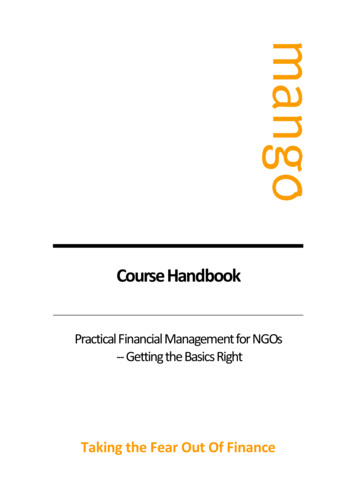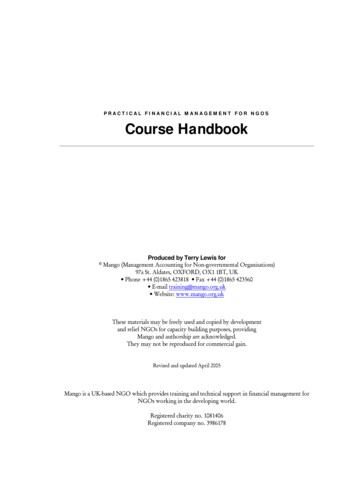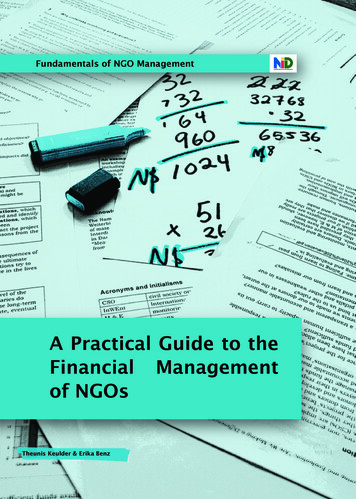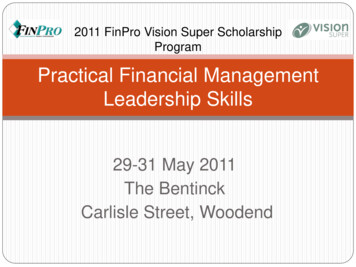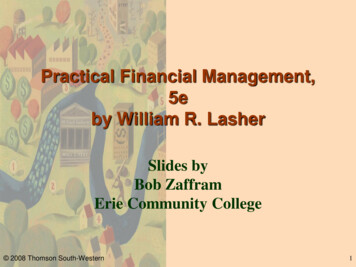
Transcription
Practical Financial Management,5eby William R. LasherSlides byBob ZafframErie Community College 2008 Thomson South-Western1
Chapter 1Foundations 2008 Thomson South-Western2
An Overview of FinanceInvestments and financial marketsFinancial management of corporations Fields are separate but related3
Financial AssetsReal asset—an object that provides aservice, such as a house, car, art, coin Financial asset—a document representinga claim to future income Stock represents ownership interest Bond represents a debt relationshipInvesting involves buying financial assets inthe hope of earning more money (a return) Investments can be made directly orindirectly through a mutual fundA Security is a financial asset that can betraded among investors4
Financial MarketsFinancial assets, issued by corporationsto raise money, are bought by investorsin financial markets A framework or organization in whichpeople can buy/sell securities Best known financial market isthe stock market– Stock exchange at center Stockbroker is licensed to tradesecurities5
Simplified Financial SystemFigure 1.16
Raising MoneyThe most common use of the wordfinance involves raising money toacquire assetsForms of Financing Issuing stock - equity financing Borrowing money - debt financing Bank Issuing bonds Leasing is like borrowing Internal financing - retaining earnings7
Raising MoneyThe field of finance deals with bothraising and investing money, but:Changing Focus of Finance Past - finance was limited tofinancial market activity Now - it includes: Goals and activities of investors: Portfolios The financial management of organizations8
Financial ManagementThe management and control of moneyand money-related operations within abusinessCFO – Chief Financial Officer Executive in charge of financedepartment9
Financial ManagementFunctions of the finance department: Keeping recordsReceiving payments from customersMaking payments to suppliersBorrowing fundsPurchasing assetsSelling stockPaying dividendsAnalysis of business decisionsOversight of other departments10
Business DecisionsFinance department provides analyses to: Determine which assets are purchased Acquiring another firm Expanding operations Decide how those assets are financed Equity DebtOversight Finance department oversees howother departments spend money11
The Price of Securities—A LinkBetween the Firm and the MarketTwo sides of finance – investments andfinancial management – connected sincefirms sell securities to investors in financialmarketsInvestors buy securities for the future cashflows expected from themLink between company management andinvestors comes from this relationshipbetween price and expected financial results12
Finance and AccountingAccounting System of recordkeeping designed toportray a firm‘soperations in afair/unbiased manner Generate financialstatements which areprovided to themarketplaceFinance Process of decisionmaking related toraising money,analyzing results Use the outputgenerated byaccountants asinputs in finance13
Finance and AccountingFinance department generally consistsof both the accounting and treasurydepartments Controller is in charge of theaccounting department Treasury department deals withother financial activities14
Finance Department OrganizationFigure 1.215
The Importance of Cash FlowAccounting createsstatements that aredesigned to portraywhat is physicallyoccurring innumbersFinance is concernedwith current andfuture cash flowIn finance:Cash is King16
The Importance of Cash FlowExampleQ: Example: In 1999 we purchased a 1,000 asset that willbe depreciated over five years using straight-linedepreciation. Explain how that asset will be viewed fromboth an accounting and finance viewpoint.A: Accounting: The initial cost of the asset of 1,000 will bereflected on the books as will the 200 annualdepreciation.Finance: We are interested in the 1,000 cash outflowand the taxes saved from the depreciation deduction—notthe depreciation itself.17
The Language of FinanceAccounting is the language of finance Finance professionals needsome accounting knowledge Level of accounting knowledgedepends on job– Financial analyst needs to know LOTS of accounting– Stockbrokers do not need as much18
Financial Theory—The Relationshipwith EconomicsModern financial theory began as abranch of economics in the 1950s Originally called ―financial economics‖Today finance is a separate field19
The Influence of Accounting, Economics andFinancial Theory on Financial ManagementFigure 1.320
Forms of Business Organizationand Their Financial ImpactBusinesses can be legally or organized as A sole proprietorship A partnership A corporationLegal organization has an impact on Raising money Taxation Financial liabilityFor financial purposes combine partner/proprietor21
The Proprietorship FormEasy to startTaxes Profit is taxed as personal income Taxed only onceRaising money If going outside the firm, a proprietorship mustobtain a loan Lending money to a new business is risky– Best outcome: repayment of principal and interest– Worst outcome: lose everything– Most new businesses fail Result: Collateral required22
The Corporate FormGetting started Requires a legal incorporation process Takes time, work and moneyTaxes Double taxation Corporation pays corporate taxes on income Dividends paid to owners are taxed aspersonal income23
The Corporate FormExampleExample 1.1Q: Ruth Samson owns a business that earns 100,000 beforetaxes. She wants to take the earnings home and spend them onherself. Assume a simplified tax system in which the rates are34% for corporations and 30% for individuals with tax ondividends capped at 15%. Compare the total tax bills under thesole proprietorship and corporate forms of organization.A:Pretax earningsCorporate tax (34%)Earnings/dividendPersonal tax (15%, 30%)NetCorporate 100,00034,000 66,0009,900 56,100Proprietor 100,000 100,00030,000 70,00024
The Corporate FormRaising Money Borrowing– Same issues faced by sole proprietorship BUT the entrepreneur can now offerstock (equity) to investors– If sell less than 50% can maintain control From the investor‘s perspective– Stock is a risky investment but the reward may be worth it» Worst possible outcome: may lose the investment» Best possible outcome: may get rich25
The Truth AboutLimited LiabilityLimited liability states that a stockholder is notliable for a corporation‘s debts Implies that the most a stockholder can lose is 100%of his investment in the stock True for owners not involved in the businessHowever, for owner operated small businesses Personal guarantees make entrepreneurs liable forloans made to their business Legal system holds individuals liable for negligence These destroy the value of limited liability26
S-Type Corporations and LLCsMajor advantage: Treated as a partnershipwith respect to federal income taxes LLC is replacing S-typeGovernment encourages formation of smallbusinesses because they create jobs S-type corporations and LLCs Let small businesses avoid double taxation Offer limited liability Offer the ability to sell stock to raise money27
Goals of ManagementEconomics—goal is to maximize profit Runs into short/long run problems What about R&D?Finance—goal is to maximize stockholders‘wealth by maximizing stock price Bypasses the concern of whether the short-term orlong-term is more important, because stock priceset in the financial market incorporates both!28
Stakeholders andConflicts of Interest Stakeholders that have an interest in the waythe firm is operated include: reditorsSuppliers29
Conflicts of InterestAn IllustrationExample: Employees want management tobuild an athletic facility on corporate grounds Benefit—more effective employees (feel better,happier, therefore more productive) Cost—will come from profits that belong tostockholders Represents a conflict of interest betweenstockholders and employees What if the request was for healthier workingconditions?30
Management—A PrivilegedStakeholder GroupOwnership of a widely held companyis very dispersed so no one has enoughcontrol to influence/remove managementAllows top management to becomeentrenched in positions controllinglarge amounts of resourcesManagement can use resources for their own benefit31
The Agency ProblemConflict of interest between stockholders andmanagement Agent is hired by a principal and given decision-making authorityThe Abuse of Agency Privileges and luxuries provided to executives - ‗perks‘Controlling the Agency Problem Manage the agency problem by: Monitoring management (audits) Tying executive compensation to stock performance32
Creditors Versus Stockholders—AFinancially Important Conflict of InterestCreditor - anyone owed money by a businessincluding lenders, vendors, employees, or thegovernmentIf actions of the borrowing firm becomeriskier than before loan, creditors/lendersare subject to more risk But risk taking rewards all go to stockholdersLenders put clauses in loan agreements toprevent this33
Investments and financial markets Financial management of corporations. Fields are separate but related. 4. Financial Assets. Real asset—an object that provides a service, such as a house, car, art, coin . Financial asset—a document representing a claim to future income. Stock represents ownership interest Bond represents a debt relationship.

